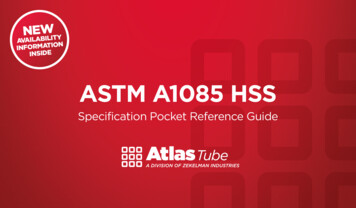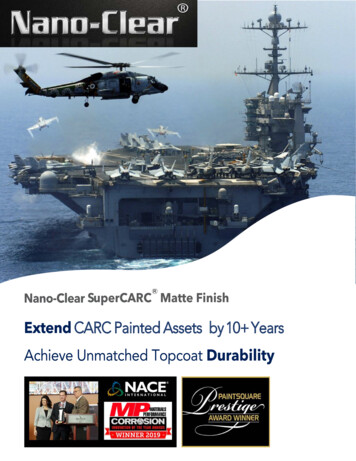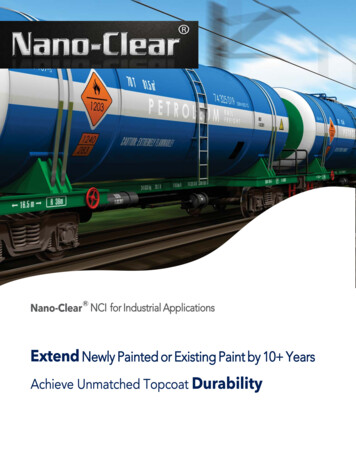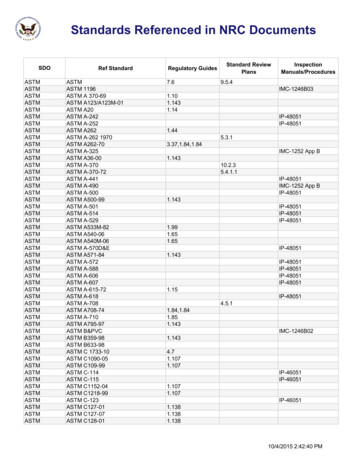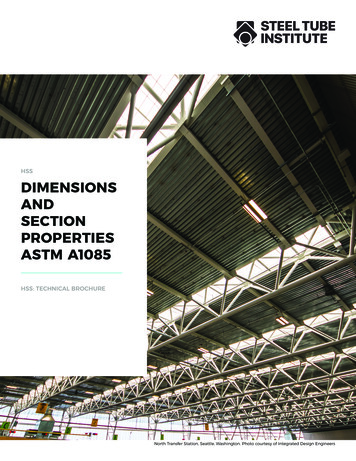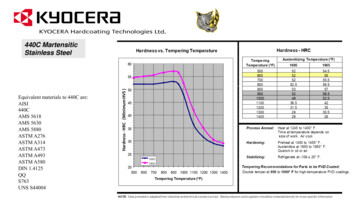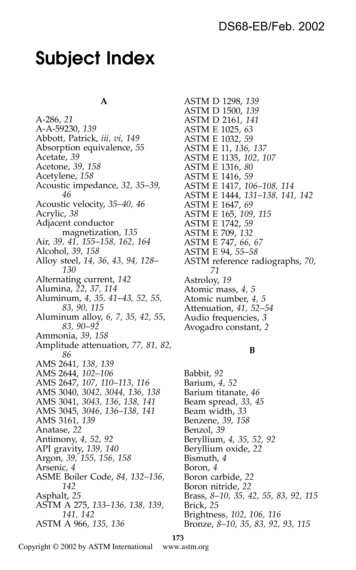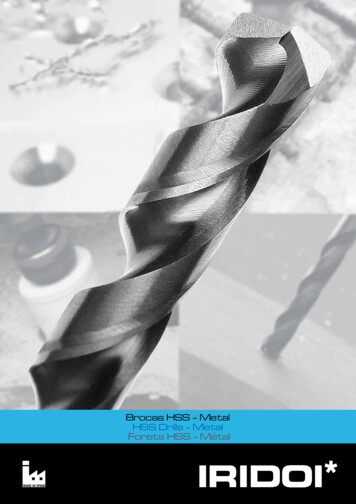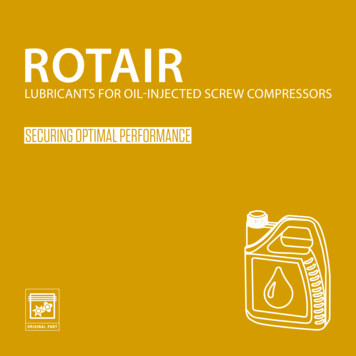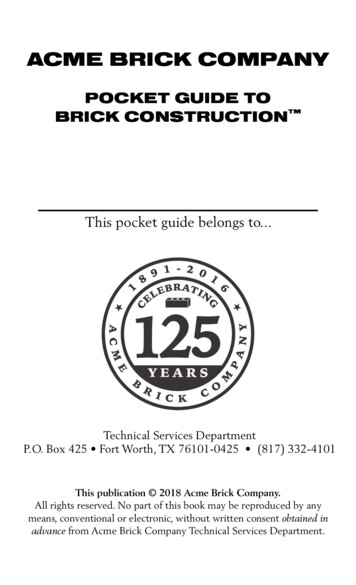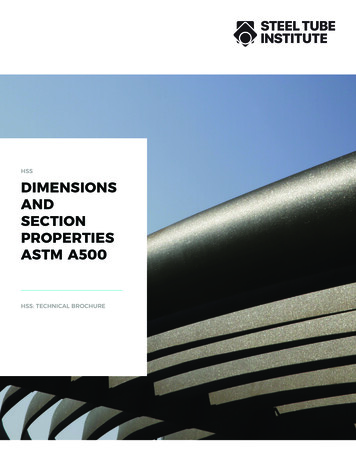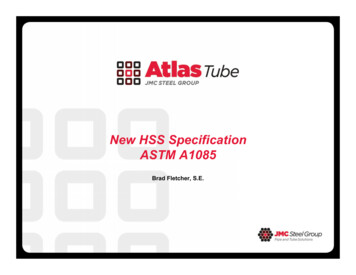
Transcription
New HSS SpecificationASTM A1085Brad Fletcher, S.E.
JMC Steel Group Family
Strategically Located Production FacilitiesCorporate headquartersAtlas Tube division Winnipeg, MB Structural tubing and pilingWheatland Tube divisionEnergex Tube divisionSharon Tube division Plymouth, MI Structural tubing Chicago, IL Galvanized squares,rounds and rectangularEMT, IMC fence andsprinkler tubing Chicago, IL Structural tubing and piling Atlas HQ Chicago, IL-Corporate HQ Cambridge, OH Electrical fittings Harrow, ON Structural tubing and piling Warren, OH Grade B, API, sprinkler,Welland, ON Line pipe;OCTG capabilitiesHS-83K, conduit shells andOCTG Sharon, PA Mill Street: A-53 standard pipe,conduit shells, lance pipe,and A-106 seamless pipe (idled) Pipe Warehouse: Threadingand hydrotesting of OCTG Dock Street: Wheatland HQ Wheatland, PA Council Avenue: CW A-53standard pipe, API line pipe,F-1083 fence, coupling stock,standard and conduitcouplings, rigid conduit,sprinkler, and conduit shells Wheatland, PA Blytheville, AR Structural tubing andpiling; OCTG capabilities Thomasville, AL Line pipe; OCTG capabilities- Church Street: DOM mechanicaltubing Niles, OH ERW hollows for DOMmechanical tubing
Atlas Tube – Market Leader Largest size range in North America 1”–16” square, up to 5/8” wall 1.25” – 20” round, up to 5/8” wall Now offering Jumbo HSS Shortest rolling cycle in the industry 2 – 3 weeks for common sizes Able to roll custom lengths to minimize cost, waste, columnsplices Rolled lengths up to 135 ft. for rounds, up to 85 ft. for sq. & rect. Four production facilities in North America Metallurgists and Structural Engineer on staff to assist withtechnical and product questions Products stocked by service centers across North America
Jumbo HSSThrough a partnership with NSMP &Mitsui, Atlas is now offering large HSS 10” & 12” sq. x .750”14” & 16” sq. x .750”, .875”18” & 20” sq. x .5”, .625”, .750”, .875”22” sq. x .750”20” x 12” x .750”24” x 12” x .5”, .625”, .750”Material stocked and readily availableLarge quantities can be mill orderedAvailable as A500 or CSA G40Also available in new ASTM A1085
Jumbo HSS Jumbo HSS listed onAISC website asavailable throughAtlas November 2011Modern SteelConstruction article Column DesignTables in AISC formatavailable to downloadfor free from AISCwebsite www.atlastube.com/jumbo-hss www.aisc.org/hss
Hollow Structural SectionsThe use of HSS is growing inpopularity in the building industry. 15% of the U.S. structural steelmarket 30% of the market in Europe,Canada and Japan 10 times more HSS per capitaused in Canada than USPopular structural uses include: Columns Trusses Bracing AESS applications
Common HSS SpecificationsRoundorSquare?wall thicknessmaterialdesignationt 0.625”any thicknessASTM A500ASTM A500ASTM A53 Gr. B“Pipe”Gr. B Fy 46 ksiGr. B Fy 42 ksiGr. C Fy 50 ksiGr. C Fy 46 ksiFy 35 ksiHSS 5.500x0.258PXX5HSS 5x3x3/8
ASTM A500
AISC HSS Committee Formed in 2007The mission of the committee is to promote the use ofstructural steel and HSS through education, research andmarketing.The committee is comprised of member HSS producers,professors, researchers and HSS users.Development of new specification to address “bad press” frompoor quality of imported HSS and poor performance of HSS inemerging seismic research.
HSS – Our ChallengeUS Design CodesCodes have evolvedover the yearsdemanding a higherlevel of performance,especially in seismicregions.Design firms look forhigh performanceproducts for buildings,bridges anddynamically loadedstructuresCritical StructuresEngineering FirmsElevating safetyfactors in all aspects ofdesignWhat’s Missing?
HSS – Our SolutionUS Design CodesCodes have evolvedover the yearsdemanding a higherlevel of performance,especially in seismicregions.Design firms look forhigh performanceproducts for buildings,bridges anddynamically loadedstructuresCritical StructuresEngineering FirmsElevating safetyfactors in all aspects ofdesignReady to meet /exceed futuredemands todayHigh Performance HSS
Why?Seismic Applications About half of the buildings designed and constructed in NorthAmerica have some level of seismic design requirements Seismic design has evolved In North America, HSS are commonly used as bracingmembers in braced frames in seismic zones In Europe & Asia, HSS commonly used as columns andbracing in seismic zones Researchers are looking for more innovative ways to utilizethe advantages of HSS in building and bridge design.
Seismic Design Has Evolved
Seismic Design Has Evolved
Seismic Design Has Evolved
Seismic Design Has Evolved 1994 Northridge, CA earthquake Spurred 10 years of research ASTM A992 was developed in response to observedconnection failures Capacity Design – members and connections designed formember capacity Seismic designs now take into account variability of materialproperties. Over-strength factors (based on that variability) are applied toensure ductile failures.
Seismic Design Has EvolvedRequiredstrengthof membersconnectionsSeismicDesignHasandEvolvedis based on the expected yield and expectedtensile stress:Ry*FyRt*FuASTM A992 Ry 1.1 Rt 1.1ASTM A500 Ry 1.4 Rt 1.3ASTM A53 Ry 1.6 Rt 1.2Impact: Higher design force leads tolarger, more expensive connections andto increased sizes of column and beamsections in steel frame. This leads tomore cost associated with using HSSbracing members versus other types ofsteel sections.Up to 40% increaseof design force forA500 HSS
HSS Mechanical Properties Current HSS andpipe specs onlyspecify minimumyield strength Maximum yieldstrength is requiredto lessen variabilityof material strengthand loweroverstrength factors(Ry & Rt)Yield Strength, min (ksi)Tensile Strength (ksi)Elongation in 2 in, min %Yield Strength, min (ksi)Tensile Strength (ksi)Elongation in 2 in, min %Yield Strength, min (ksi)Tensile Strength (ksi)Elongation in 2 in, min %Yield Strength, min (ksi)Tensile Strength (ksi)Elongation in 2 in, min %Square, Rect & Round HSS - CSA G40Grade 50W5065 - 9022Square & Rect HSS - ASTM A500Grade BGrade C465058622321Round HSS - ASTM A500Grade BGrade C424658622321Round Pipe - ASTM A53Grade B3560Varies
Seismic Research“Design Implications of Recent Research on SCBF”by Uriz, Sabelli and Mahin“Square and rectangular HSS have limited ductility capacity asbuckling braces of moderate slenderness. The ability of such braces towithstand buckling without premature fracture resulting from local bucklingmay be significantly less than that implied by current design provisions.These findings are consistent with past research and as witnessed inearthquake reconnaissance (For example see AIJ 1995; Bonneville andBartoletti 1996; Goel and Tang 1987; Lee and Goel 1987; Shaback andBrown 2003; Tang 1987).”“Recommendation: For braces subject to inelastic buckling the use ofround HSS, angle(s), wide flange shapes, or other sections as braces inlieu of square and rectangular HSS is recommended”.
RHS Corner Behavior under Seismic LoadingCold-formed square hollow sections have a real Fy / Fu ratio which issometimes very high (0.85 to 0.95), even in the flats, and squarehollow sections are prone to fracture in the corners after localbuckling, even with low b/t ratios
Why?Bridge Applications Vehicle and pedestrian bridges are governed byAASHTO. ASTM A709 has Charpy requirements HSS becoming more popular for bridges in US
New Bridge Construction ASCE Infrastructure Report Card – US bridges have a C rating ASCE recommends 930 Billion of spending to improve USRoads & Bridges The AWS (American Welding Society) has recently formed aTubular Task Group to develop a document for tubular bridgeconnections that is suitable for use by AASHTO. Provisions areto be tailored for use in welded tubular bridges. Huge potential for HSS usage in bridges if material propertiesare improved
BridgesTubular bridges are becoming more popular
Bridge Design CVN – Charpy V-Notch High strain rate testMeasures amount of absorbed energyduring fractureIndicates material’s toughnessTool to study material’s temperaturedependent ductile-brittle transition AASHTO requires CVN of 25 ft-lb @ 40o F Some DOT design manuals do not allowA500 to be used, unless the min CVNrequirements are met CVN’s are also required for seismic design
TolerancesASTM A500 Wall Tolerances /- 10% on nominal thicknessAISC 360 Specification for Structural SteelBuildings Requires design thickness for A500 HSS tobe 0.93*nominal wall thicknessCISC Handbook of Steel Construction Requires design thickness for A500 HSS tobe 0.90*nominal wall thicknessNet result: Not able to fully utilize crosssectional properties of A500 material, whichdiminishes economy of HSS
Corner RadiiASTM A500 Outside corner radius not toexceed 3t No lower limitToo tight of radius can lead to microcracking in the corners.Cracking can lead to explosive releaseof residual stresses during operationssuch as welding or galvanizing
Architectural Feature?
What Do We Want?How can a new HSS Specification make designeasier? Design with full nominal section Increased suitability in fatigue applications Seismic overstrength control Better control of galvanizing Better control of corner radii
ASTM A1085YieldStressTensileStressASTM A500Grade BGrade CRound42 ksi min46 ksi minSq/Rect46ksi min50 ksi minRound58 ksi min62 ksi minSq/Rect58 ksi min62 ksi minASTM A1085AllShapes50 ksi min70 ksi max65 ksi min
ASTM A1085ASTM A500ASTM A1085Wall thickness-10%-5%Mass toleranceN/A-3.5%
ASTM A1085ASTM A500Corner radiir 3tASTM A1085t 0.400”1.6t to 3.0tt 0.400”1.8t to 3.0t
ASTM A1085CVNSupplementalRequirementsAtlas Tube/JMCASTM A500ASTM A1085N/A25 ft-lbs@40FN/AOptional heattreatingOptional varyingCVN
ASTM A1085ASTM A500ASTM A1085Carbon, 50.035Sulfur, max0.0350.035Aluminum,minN/A0.15/0.20Copper, min0.20N/ASilicon, maxN/A0.04*Maximum carbon equivalent of 0.45 is also specifiedMinimum Al content specified .020% min total Alcontent Guarantees use of fullykilled, fine-grained steel This is current typicalpractice, but spec nowmandates it.Maximum Si content specified .04% max Helps avoid SandelinEffect Aids galvanizing process
HSS Spec Comparison ChartYieldStrengthksi, minTensileStrengthksi, minElongation%, rRadiusA500 Grade BRnd 42Sq/Rec 46No Max58No Max23NA-10% 10%NA3t MaxA500 Grade CRnd 46Sq/Rec 50No Max62No Max21NA-10% 10%NA3t MaxCSA G40 50W50No Max65 – 9022Cat 1: 20 ft-lbo@ 32 FCat 2: 20 ft-lbo@0 F-5% 10%-3.5% 10% 6x6x.5Varies (2t-4t) 6x6x.53t maxA53 Grade B35No Max60-NA-12.5%-10%NAAPI 5L PSL X52N52No Max67-20 ft-lb @ 32F-10%1/4” t 5/8”-3.5%regular plainendNAEN10210 S355J2H51.5 fort 5/8”No Max682220 ft-lb @ 0F-10%-6%3t Max-10% t 1/4’’ 0.02’’ t 1/4’’ &D 16’’-6%t 1/4” 1.6t2.4t¼” t 3/8” 2t3tt 3/8” 2.4t3.6t-5% 10%-3.5% 10%t .4”1.6t - 3.0tt .4”1.8t - 3.0tEN10219 S355J2HASTM A108551.5 fort 5/8”No Max50 - 706865ooo2020 ft-lb @ 0F2125 ft-lb @ 40Fo
ASTM A1085 and the Codes Proposed: Added to approved materials list in ASIC 360,Chapter A3 Proposed: Added language to AISC 360, Chapter B4 thatallows the full nominal wall thickness to be used as the designwall thickness for HSS produced to ASTM A1085. A500 HSSwill still need to be reduced by the 0.93 factor. Proposed: Added to Group II of Table 3.1 in AWS D1.1. Addedto Group II because of the higher Fy over A500 material.
A1085 & Welding Chemistry of A1085 is essentially the sameas A500. A1085 will be an AWS Group II material. Currently, A1085 is not a prequalifiedmaterial so a Procedure QualificationRecord (PQR) will need to be performed. To avoid the need to do qualification, askfor material to be dual certified to A1085 &A500, Grade C Once the next AWS is published, A1085should be a prequalified material
Design ComparisonHSS 8 x 8 x 1/2ASTM A500 Gr. BASTM A1085Design Wallthickness, t (in.)0.4650.500Nominal Wt. (lb/ft)48.8548.85Area, A (in.2)13.514.4I, (in.4)125131S, (in.3)31.232.8r, (in.)3.043.02Z, (in.3)37.539.7
Design ComparisonHSS 8x8x1/2 Column, KL 15 ft, LRFDASTM A500 Gr. B ASTM A1085 Pn 441 kipsPn 500 kips Increase of 13%
Design Comparison8” HSS Column, Pu 380 kips, KL 15 ft, LRFDA500 Gr. B:HSS 8x8x1/2 (48.85 plf) HSS 8x8x3/8 (37.69 plf) Pn 441 kipsPn 343 kipsA1085:HSS 8x8x3/8 (37.69 plf) Pn 390 kips Weight savings of 23%
Benefits of New SpecMinimum and Maximum values for Yield Stress Expected for seismic design. Will hopefully result in lower Ry, which will make HSSmore economical choice for bracing members. If the upper yield stress is not controlled then it makesit difficult to pick HSS for energy-dissipating elements. New Specification will be only one in the world to capyield stress.
Benefits of New SpecMinimum Charpy Notch Toughness Expected for all dynamically loaded structures. The minimum requirements of AASHTO will be met.
Benefits of New SpecTighter thickness and mass tolerances This will enable the 0.93t design thickness in theUS and .90t in Canada to be abolished. Using nominal thickness as design thickness willincrease HSS column capacity.
Benefits of New SpecRevised Corner Radii Help limit corner crackingRevised Chemistry Guarantees fully-killed, fine grained steel Aids in galvanizing process
ASTM A1085For additional information: www.atlastube.com/astm-a1085 www.aisc.org/hss www.aisc.org/a1085 on-astm-a1085
Questions?THANK YOU!www.atlastube.com
Hollow Structural Sections The use of HSS is growing in popularity in the building industry. 15% of the U.S. structural steel market 30% of the market in Europe, . to increased sizes of column and beam sections in steel frame. This leads to more cost associated with using HSS bracing members versus other types of steel sections.
